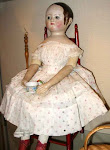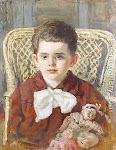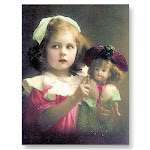 Kestner shoulder head with modelled ornament comb, and extravagantly painted blouse with modelled collar, frills and bow. Blue glass eyes and feathery eyebrows, closed mouth with contour and red dividing line ca. 1880
Kestner shoulder head with modelled ornament comb, and extravagantly painted blouse with modelled collar, frills and bow. Blue glass eyes and feathery eyebrows, closed mouth with contour and red dividing line ca. 1880
Until today, it was not definite who in Europe the first to manufacture porcelain doll heads was. The Royal Porcelain Manufacture (KPM) Meissen was one of the earliest producers. Initially the first dolls were produced as byproducts and only test models. At that time, Meissen made porcelain dishware and extravagant artistic porcelain.
In eighteen forty, the first porcelain doll heads were produced commercially. Meissen produced head with elegant lady faces which differed from the later little girl doll faces.
 Bisque shoulder head attributed to "Kestner", modelled costume hood, three rowed gold colored necklaceand blouse upper part with bows, characteristic Kestner's one stroke eyebrows, closed mouth with dark red dividing line, ca. 1885
Bisque shoulder head attributed to "Kestner", modelled costume hood, three rowed gold colored necklaceand blouse upper part with bows, characteristic Kestner's one stroke eyebrows, closed mouth with dark red dividing line, ca. 1885
 Bisque shoulder head attributed to "Kestner", modelled bonnet with flower trimming and bow. ca.1885
Bisque shoulder head attributed to "Kestner", modelled bonnet with flower trimming and bow. ca.1885


Often frills and flowers were added to the dolls. Yet they weren’t called proper toy dolls and not suitable for children. They were still ornamental porcelain that pleased the eye. Some small children were given these dolls as presents. The precious doll was kept safe until the child had attained the right age and necessary maturity to appreciate the doll. As a result, many of these dolls remain today.
 " Dresden Gentleman"
" Dresden Gentleman"

 ABG "Empress Augusta" a portrait doll.. bisque shoulder head with modelled on jewelry, modelled blouse upper part with blue stripe (also found in pink) modelled black cross
ABG "Empress Augusta" a portrait doll.. bisque shoulder head with modelled on jewelry, modelled blouse upper part with blue stripe (also found in pink) modelled black cross
Ca. 1880 Thuringia Germany

 Child posing with "Limbach" stone bisque doll with modelled bonnet
Child posing with "Limbach" stone bisque doll with modelled bonnet
wax and cloth body with celluloid forearms... ca. early 1900
By 1850 manufactures began to realize that porcelain heads with all of their beauty and strong glossiness seemed unnatural and were thus not perfect. They directed their attention towards an especially fine, white, dull, and transparent type of porcelain: which was called Parian.
 The English developed the first parian-ware in the 1840s, and exhibited parian-ware figures at the London International Exhibition in 1851. These figures proved to be very popular, inspiring the Germans to develop their own version of parian porcelain. Soon the many competing German Thuringian companies began making doll heads and limbs in the unglazed white porcelain bisque. They found that they could achieve a higher degree of detail in the modeling than had been possible with the glazed china pieces. Therefore parian dolls can be found with more elaborate hairstyles and in greater variety than the glazed china dolls. There were so many porcelain factories in Thuringia, that it is often very difficult to tell which company made a specific doll. They copied each other's popular models, and employees drifted back and forth between factories.
The English developed the first parian-ware in the 1840s, and exhibited parian-ware figures at the London International Exhibition in 1851. These figures proved to be very popular, inspiring the Germans to develop their own version of parian porcelain. Soon the many competing German Thuringian companies began making doll heads and limbs in the unglazed white porcelain bisque. They found that they could achieve a higher degree of detail in the modeling than had been possible with the glazed china pieces. Therefore parian dolls can be found with more elaborate hairstyles and in greater variety than the glazed china dolls. There were so many porcelain factories in Thuringia, that it is often very difficult to tell which company made a specific doll. They copied each other's popular models, and employees drifted back and forth between factories.

 Parian nurse maid and child; doll house dolls ca. 1880
Parian nurse maid and child; doll house dolls ca. 1880 " Little mothers playing house"
" Little mothers playing house"
 Beautiful "Kling" shoulder head made from bisque porcelain; blue paperweight glass eyes, leather body with bisque forearms ca. 1880
Beautiful "Kling" shoulder head made from bisque porcelain; blue paperweight glass eyes, leather body with bisque forearms ca. 1880

styled modelled as a young cavalier...ca. 1865
Young lady made of bisque porcelain C.F. Kling...Thuringia, Germany, ca. 1880
The period of the exquisite Parian dolls was quite short because they were still not suitable for child’s play. In addition, their white marble skin color was unnatural so the porcelain was painted flesh-like tone and then was not called Parian but bisque.
Many Parian dolls are around today because owners knew of their fragility and kept them safe. Children could only play with them as they matured. That is a good thing. I believe these dolls were some of the most beautiful dolls produced.
Many Parian dolls are around today because owners knew of their fragility and kept them safe. Children could only play with them as they matured. That is a good thing. I believe these dolls were some of the most beautiful dolls produced.













































.jpg)







































































Beautyful dolls, Marta.
ReplyDeleteEs una suerte para nosotros, que no se les permitiera a los niños jugar con ellas. pero cruel para esas pobres criaturas. "¡Mira que muñeca más preciosa! La guardaremos en un cajón hasta que tengas pretendientes."
Es dramático que fueran tan preciosas pero tan frágiles. La paradoja es que esa fragilidad, es la que ahora las haga tan preciadas y valoradas. Siempre pienso en todas las que se habran destruido a lo largo de esa época. Eso que estoy seguro de que las niñas de esa época, eran más cuidadosas con estas muñecas que las que hoy en día juegan con Barbies.
Muy interesante post, Marta.
Gracias y besos.
¡No puedo creer que sea tu primer comentario!
What beautiful objects, real works of art. And I love the Little Mothers photo.
ReplyDeleteVery sweet and tender dolls.
ReplyDeleteSiempre me han fascinado las muñecas parian, me parecen bellísimas con esas caritas tan blancas!! La colección que nos muestras en esta entrada es sensacional!! Un besazo enorme y un millón de gracias por compartir con todos nosotros estos conocimientos que tienes sobre el mundo de las muñecas!!
ReplyDeleteMuchas gracias a todos..Estas muñecas me fascinan. Son verdaderas obras de arte, me fue dificil decidir cuales demonstrar pues todas son preciosas.
ReplyDeleteThank you all for sharing my love for these dolls, they surely are unique and we are so lucky there are still many to be found intact.
Bisous
Marta
Dear Martha, how I wish, for once, take in my hands one of these dolls ...
ReplyDeleteI'd be a happy child!
Is really impossible to elect the most beautiful
:-)
Mini hugs, Flora
You've managed once again to completely draw me into your lovely doll world Marta!!
ReplyDeleteI THANKYOU!!!!
♥Nan
Your posts are always so interesting and you find such wonderful images. I specially like the pin cushion doll. Pan x
ReplyDeleteFlora, Nan, Pan...How wonderful to hear from you!
ReplyDeleteSo glad you like this post. These dolls are enchanting, so beautiful and delicate. This was a very rewarding post to research, I was so glad I found such lovely dolls to show you.
Bisous
Marta
Beautiful and I love all the different hairstyles.
ReplyDeleteDear Marta, I like your blog so much. My interest in old dolls startet only a few months ago - but it grows every day. I want to show you two doll heads: Please follow me to my first post :
ReplyDeletehttp://apropos-apropos.blogspot.com/2010/05/eure-durchlaucht.html
I was asked how old they are but I don't know. "She" looks like your Augusta but without decoration and who could be "Him". Could it be that they are also from nearly 1880 - made by Alt, Beck & Gottschalk? I'm not sure. Perhaps you have an idea. And could you please also have a look on my header - they boy with the rose. I don't know from where and how old he is.
Thank you so much!!! Best wishes from Germany, Carola